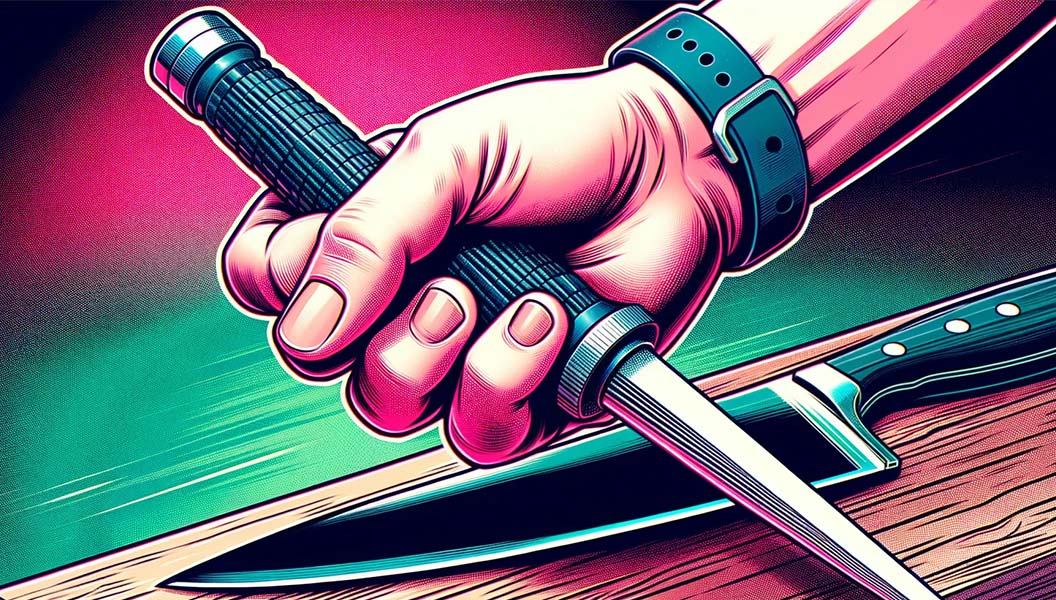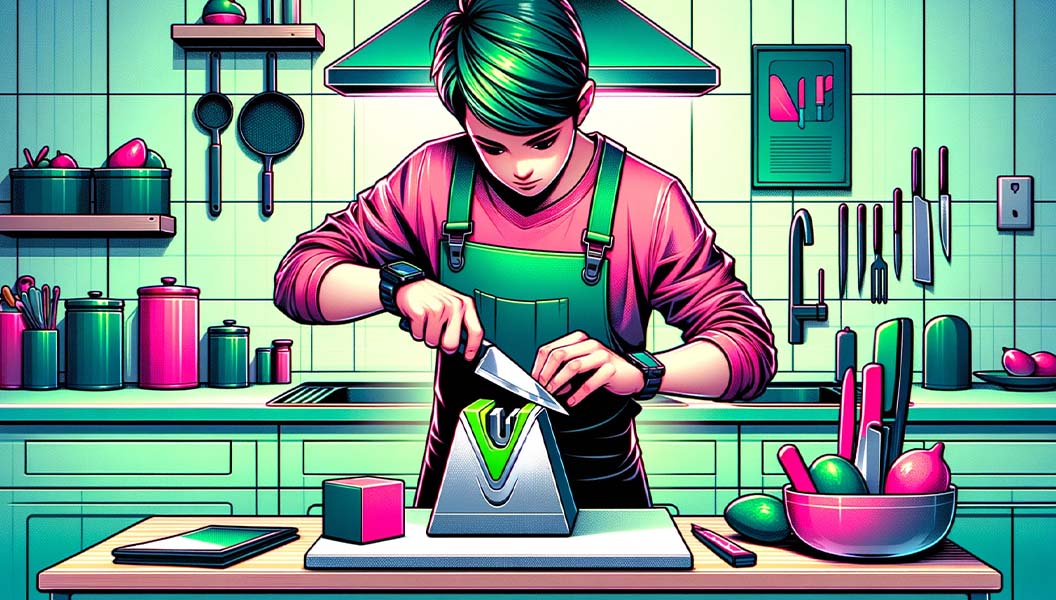There's nothing quite like the satisfaction of cutting through perfectly cooked steak with sharp steak knives that effortlessly glide through its tender fibers. If you are particular about the sharpness of your knife, then you most likely have sharpened your kitchen knives before. Unlike flat-blade knives, serrated knives are trickier to sharpen.
In this post, we will share how to sharpen serrated steak knives and your bread knife, as sharp knives are the key to a happy kitchen! So ditch your dull knife and explore three different ways to sharpen serrated knives. Here are tips for keeping your knives sharper and longer.
What You Need To Consider Before Sharpening Steak Knives
Knife Material And Quality
Different knives are made from various materials, such as stainless steel, carbon steel, or high-carbon stainless steel. Every material possesses distinct traits that can impact the sharpening process. Additionally, the quality of the knife plays a significant role in how well it holds an edge. High-quality knives often have harder blades that require special techniques and tools for sharpening.
Frequency Of Use
The frequency of your usage of steak knives will determine how regularly they require sharpening. If you frequently prepare meals that involve cutting through tough ingredients or bones, your knives might require more regular sharpening. Conversely, using them sparingly allows for less frequent sharpening.
Current Knife Condition
Before you start sharpening, assess the current condition of your steak knives. Are they simply dull, or do they have nicks or chips in the blade? Different levels of damage will require varying approaches to achieve optimal results.
Knife Blade Types
Steak knives have either straight or serrated blades. Straight blades feature a smooth and flat edge, whereas serrated blades possess a saw-like edge characterized by small, pointed teeth. The type of blade greatly influences the sharpening process.
Steak knives with straight edges are commonly sharpened using whetstones, honing rods, and electric or professional knife sharpeners. These approaches entail crafting a precise, keen edge along the complete length of the blade. Pay attention to the angle at which you're sharpening, as consistent angle control is crucial for achieving a uniform edge.
Sharpening serrated steak knives requires a different approach due to the teeth-like edge. Instead of sharpening the entire edge, you'll focus on individual serrations. Specialized sharpeners, known as serrated knife sharpeners, have grooves that match the size of the serrations, allowing you to sharpen each serration accurately.
Some steak knives have a combination of straight and serrated edges. In this case, you must apply different sharpening techniques to each blade section. Start by sharpening the straight edge using the appropriate method, then move on to the serrated section.
Sharpening Tools And Equipment
There are multiple methods for sharpening knives, including whetstones, sharpening rods, electric sharpeners, and honing guides. Each method has pros and cons, and your choice should align with your comfort level and the specific requirements of your knives.
Understanding The Blade Edge
The blade edge is the part of the knife that does the cutting. It's important to understand the characteristics of the blade edge, such as its angle, bevel, and condition, before embarking on the sharpening process.
The angle at which the blade is honed is referred to as the bevel angle. It greatly affects the sharpness and durability of the edge. Different knives have different recommended bevel angles based on their intended use and the type of steel they're made from.
Steak knives usually feature dual bevels, indicating that both sides of the blade are angled. However, some knives, especially traditional Japanese knives, might have a single bevel. Knowing whether your steak knives have a single or double bevel will determine how you approach the sharpening process.
How To Sharpen Your Own Serrated Knives Using A Ceramic Sharpening Rod

The most conventional method for sharpening serrated knives involves using a ceramic sharpening rod. The ceramic rod will have an ergonomic handle attached to the ceramic honing rod. They are available in various grit grades, but you should opt for a rod with a grit of 1000. Doing so gives you a sharp edge on your serrated knives.
- Examine your serrated knives to identify any visible nicks or damage along the blade edge. If you notice significant damage, consider using a more intensive sharpening method or seek professional assistance.
- Hold your serrated knife with the pointed part of the blade facing away from you for safety purposes.
- Insert the sharpening rod into one of the serrations and slowly and gently draw it through the serration downwards.
- Repeat the process with the same serration multiple times, using an individual motion each time. Don't use a back-and-forth motion! Instead, draw the ceramic rod through the serration, lift it off, and place it again before repeating the motion.
- Finish by passing the blade edge over a leather strop for a particularly fine finish.
Using a ceramic sharpening rod will give you the longest-lasting and sharpest edge of the three methods described here. Nevertheless, it is also the most time-intensive approach and requires a certain skill level.
How To Sharpen Serrated Steak Knife Using A Triangle-Shaped Sharpener

As opposed to the straight ceramic honing rod, there are also sharpening rods specifically shaped for the shape of the serrations. This narrow triangular tool can effortlessly slot into the grooves of a serrated knife.
- Hold your serrated knife with the pointed part of the blade facing away from you for safety purposes.
- Place the triangle-shaped sharpener into the serration and draw it backward through the groove.
- Repeat the process with the same serration multiple times, using an individual motion each time. Don't use a back-and-forth motion! Instead, draw the triangle sharpener through the serration, lift it off, and place it again before repeating the motion.
- Finish by passing the blade edge over a leather strop for a particularly fine finish.
This method of sharpening serrated knives also achieves a long-lasting and sharp edge. However, it is equally time-consuming as using a ceramic rod. It arguably requires more skill and patience.
How To Sharpen Steak Knives Using An Electric Knife Sharpener

Electric knife sharpeners are available if you lack the confidence, skill, or patience required to sharpen a serrated knife using a manual sharpener! Various types are available, but typically, an electric sharpener contains a motor and a series of slots containing individual sharpening rods. Using electric sharpeners varies from one model to another, so always check the manufacturer's instructions before use.
- After plugging in the electric knife sharpener, place the serrated knife's blade into the slot. Be sure to press down on the serrated blade's heel to ensure it makes contact with the grindstones.
- Turn the power on to activate the grindstone motors.
- Slide the serrated knife blade smoothly through the slot. Repeat this movement several times, sharpening the entire length of the steak knife each time.
While sharpening serrated knives using an electric sharpener is much easier, quicker, and safer than manual sharpening, this method has some cons. For one, an electric serrated knife sharpener is considerably more expensive than a single sharpening rod. You cannot also control the angle at which the sharpening stone approaches the blade. Your steak knives will not achieve as sharp a finish and will likely dull faster.
Tips For Caring For Steak Knives Properly
Although there are many methods for sharpening your steak knives, let's admit it - they are somewhat tedious. So, let's take a moment to discuss how to keep your knives as sharp as possible for as long as possible so you don't have to go through the sharpening process too frequently!
Keep Your Knives In A Knife Block
Knife blocks occupy precious countertop space. Many people choose to keep a smaller knife block for their chopping and dicing knives and store the lesser-used steak knives in a kitchen drawer. However, this will quickly blunt them! Blades dull when they come in contact with other metals (as they likely will in a kitchen drawer). Instead, opt for a knife block or a magnetic strip mounted on the kitchen wall.
Dry Your Knives Thoroughly
It's a common equation. Metal plus moisture equals rust. While you might not see red rust on your knives, any water left on them after washing them will deteriorate the metal and dull their edges.
Never Use A Dishwasher
Regardless of what is stated in the manufacturer's instructions, it would be best not to put a knife—serrated or otherwise—in a dishwasher. Dishwashers use a rather harsh washing process that will dull the serrated edge of your knives. Many different types of cooking equipment, such as nonstick cookware or wooden utensils, can be harmed if placed in a dishwasher. Knives should also be on this list.
Avoid Soaking Your Steak Knife
Avoid immersing your steak knives in water or allowing them to remain submerged. Extended contact with moisture can result in rust and harm, especially for knives with wooden handles.
Avoid Cutting Board
The steak knives are designed to be only in contact with food, not the cutting board. So slicing to the cutting board can slowly dull the knives and reduce sharpening.
